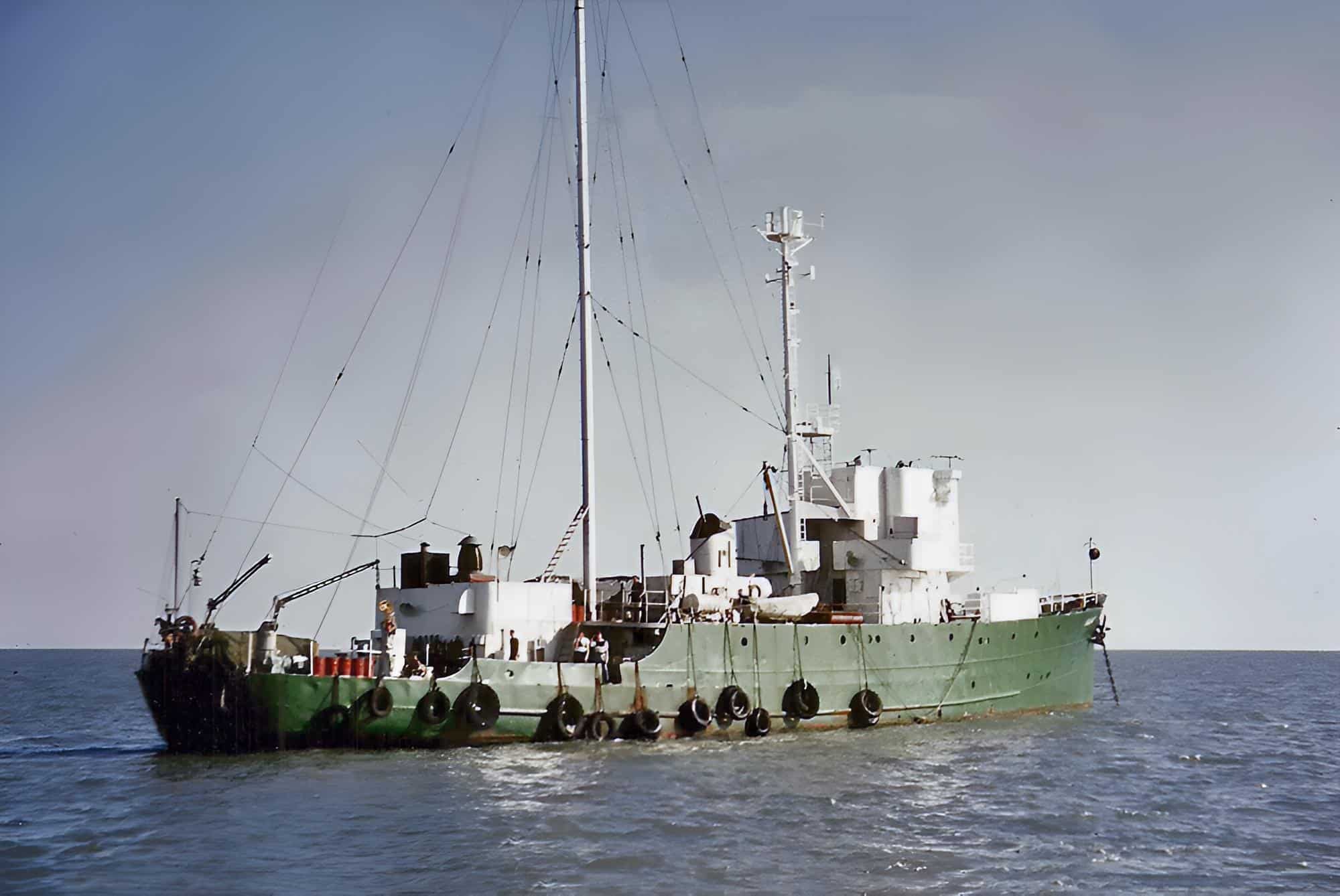Ship details: The Density was launched 6th February 1944 by Tampa Shipbuilding Co., Inc., Tampa, Florida; sponsored by Miss M. Farmwald; and commissioned 15th June 1944, Lieutenant Commander R. R. Forrester, Jr., USNR, in command. She was reclassified MSF-218, 7th February 1955.
The vessel arrived at San Diego 23rd September 1944 to serve as a training ship for the Small Craft Training Center at Terminal Island, until 2nd February 1945, when she sailed for Pearl Harbor and Ulithi.
The Density sortied from Ulithi 19th March 1945 to sweep mines preparatory to the invasion of Okinawa on 1 April. Patrolling off Okinawa for its capture and occupation, the Density fired on the enemy in several suicide attacks. On 6th April she splashed several of the huge kamikaze force which struck the Fleet, then assisted Rodman (DMS-21), picking up 16 of her survivors and towing her to Kerama Retto. On the 22nd she splashed an enemy attacker which cleared her bridge by only 10 feet, then rescued three survivors from stricken Isherwood (DD-520) before resuming her patrol. Five days later she recovered the body of an enemy officer from a plane she had downed and thus obtained valuable intelligence material including a secret code book and photographs. While sweeping mines she sank an enemy suicide boat off Naha on 4th May.
The Density sailed from Okinawa 4th July to join a group of minesweepers supporting the 3rd Fleet strikes against the Japanese homeland. From 9th to 28th August she was in San Pedro Bay, Leyte, for brief overhaul, and on 8th September put out from Okinawa to sweep mines in Japanese waters. She remained in the Far East on occupation duty until 20th November when she sailed for the west coast, arriving at San Diego 19th December. On 29th January1946 she arrived at Galveston, Tex., to provide services to the reserve fleet at Orange, Tex., and was placed in commission in reserve 14th May 1946. The Density was decommissioned there 3rd March 1947. The ship received three battle stars for World War II service.
Two Greek brothers bought the Density from the US Navy in 1960. The renamed the vessel the Manoula and used her as a small cargo ship until 1963. The Company was not profitable and the ship was moored in America whilst a buyer was found. None appeared and debts built up, mostly mooring fees. The two American businessmen Don Pierson and Ton Danaher bought the ship for $60,000 in 1964 and it converted into an offshore radio station in Miami. The ship had a powerful transmitter, studios, accommodation for the crew and space for supplies to last a long time
On 22nd October 1964 the 780 ton and 185 feet MV Galaxy, as she was now called, sailed from Miami as a fully equipped radio station for British waters and the Thames Estuary. The investment in the project came to a total of $500,000. The ship was registered in Honduras. On her way to the Thames Estuary the vessel called at San Juan in Puerto Rico and Lisbon before arriving on 19th November 1964. Mr Ronan O´Rahilly, boss of Radio London´s rival Radio Caroline, warned them that their anchorage was within British limits off the coast of Sheerness. Therefore the ship moved further up the Essex coast.
The Galaxy was not without her own fair share of incident. The general movement of water around the British Isles combined with these north easterly winds often had the disc jockeys being sick whilst on air. The ship may have been an old war-horse but she didn’t like these conditions. On 11th January 1966 at 21:00 hours transmitters were switched off. A force eight storm hits the ship. At midnight the ship started to drift and the anchor chain broke. The Galaxy drifted to within three-hundered and twenty-five feet of the Radio Caroline ship MV Mi Amigo. The Clacton lifeboat was launched but the ship was safe after drifting four miles towards Clacton Pier. On 12th January the Felixstowe tug “Kent” towed the Galaxy back to her old anchorage, off Walton on the Naze, arriving at 14:15 hours. Broadcasts resumed at 13:00 hours.
During 1966 the port of embarkation was changed from Harwich to Felixstowe. On one occasion the Galaxy had suffered very rough seas for several weeks and part of her hull gave up. A large hole appeared and water gushed in, to the surprise of the crew in the mess, but lateral thinking saved the day.
After the Marine Offences Act the Galaxy set sail for Hamburg on August 19th 1967. Here she was to be dry-docked, refitted and sold as a going radio station. However, on examination it was found that she was only being held together by her paint and an enormous amount of money was needed to get her back to a sellable commodity. Business being business dictated that the investment was not viable and the project abandoned.
After several court cases regarding the ownership of the ship she was sold for scrap in 1970 for £23,000 and moved to Kiel. Here she remained for many years where she was used a dive training vessel to practise underwater repair techniques. On April 20th 1979 the old girl gave up the ghost and sank. In 1986 she was raised due to concerns about fuel leaks and dumped on dry land for scrapping.
Offshore radio station: Radio London from 5th December 1964 (first tests) to 14th August 1967
Location: International waters off Walton-on-the-Naze, Essex (UK). The exact position was 51 degrees 47 minutes 90 seconds North, 0.0 degrees 20 minutes 55 seconds East.

